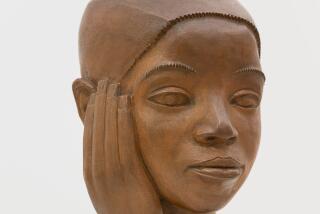Tom Wesselmann, 73; Pop Artist Mixed Elements of Fine Art and Advertising
Pop artist Tom Wesselmann, known for his large-scale paintings that mix elements of fine art and advertising and for his compositions in which classically posed nudes vie for attention with household appliances and product labels, has died. He was 73.
A longtime resident of New York City, Wesselmann died Friday at New York University Medical Center after complications from heart surgery, according to Emilio Steinberger of the Robert Miller Gallery, where Wesselmann recently exhibited his work.
Rising to prominence in the 1960s with Pop artists Andy Warhol, Claes Oldenburg and Roy Lichtenstein, Wesselmann brought the flat quality of cartoons and the giant scale of billboards to his work.
He also populated his canvases with mass-produced objects in the Pop tradition, but he added to his paintings what critics referred to as a lush sensuality.
Two images became his signatures: a series of paintings of vast female nudes with candy red lips in the ‘60s and another series of just red lips, some dangling a cigarette or releasing a cloud of smoke.
Wesselmann also made sculpture, combining the same hard-edged surfaces and intimate subjects of his paintings. One sculpture, “Belt Still Life” (1982), made of painted wood, consists of a man’s belt, a woman’s shoe and a vase of tulips.
“The arrangement does suggest a department store display window,” wrote Los Angeles Times critic William Wilson in a review of the work. “But there are stronger overtones of an accidental still life made of the components of a nice, clean-cut boy-meets-girl.”
At times Wesselmann added a three-dimensional object to a canvas, as in his “Still Life #31” (1963), in which a television is attached to a painting of fruit arranged on a kitchen table.
In that work and others he mixed icons of modern, throwaway culture with reminders of enduring artworks from the past: On the wall beside the television set hangs Wesselmann’s rendition of a famous portrait of George Washington by 18th century artist Gilbert Stuart.
Born in Cincinnati in 1931, Wesselmann was drafted into the Army during the Korean War and later attended Cooper Union School of Art in New York City.
Throughout most of his student years he planned to become a cartoonist. But, inspired by Abstract Expressionist artist Willem de Kooning -- in particular the series of large, pink nudes De Kooning painted in the 1940s and ‘50s -- Wesselmann revised his plans.
Several exhibits of his paintings in the early 1960s established him as a founding member of the Pop Art movement.
In recent years, Wesselmann startled critics with paintings that recalled the Abstract Expressionist style that had prompted the smooth-surfaced paintings of Pop Art. For example, a 1996 exhibit in New York featured wall reliefs made of cutout metal, painted in broad gestural strokes of deep blue, green and brown.
More recently he returned to fleshy nudes in a similarly expressive painting style, quite different from the plastic-smooth surfaces of his earlier works.
Wesselmann is survived by his wife, Claire, daughters Jenny and Kate and son Lane.
More to Read
The biggest entertainment stories
Get our big stories about Hollywood, film, television, music, arts, culture and more right in your inbox as soon as they publish.
You may occasionally receive promotional content from the Los Angeles Times.










